Last week, I was lucky enough to be invited (plus guest) to the Press Preview of the opening to the public of the Buckingham Palace Gardens so I asked my friend and fellow author, Sophie Weston, if she would like to come. Apart from the three Garden Parties which the Queen hosts every summer, the general public don’t usually get to see the gardens, but Covid has made the annual opening of the State Rooms and the accompanying exhibition impossible. Naturally, I said, ‘Yes, please’. Sophie and I were both looking forward to it. Normally, if you visit the State Apartments and the Summer exhibition, you come out of the palace onto the West Terrace Steps of the Palace where there is a café –
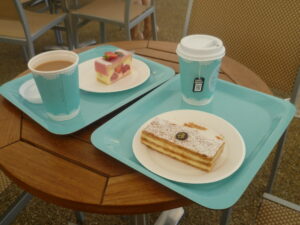
The cakes are always delicious, and I love the way that even the chocolate button on your vanilla slice has a small gold crown on it!
– and you go home via a path through the woods – passing the Buckingham Palace shop (a cuddly corgi, anyone?) and you exit near Hyde Park Corner.
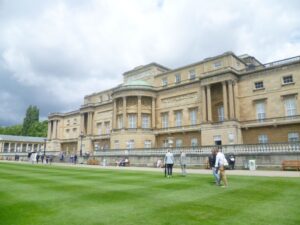
West Terrace Steps, Buckingham Palace, overlooking the Palace gardens
This time, we entered via the Royal Mews and, after following the arrows and arriving at the West Terrace, which we recognized, we decided that we would just wander round. We had both had a stressful few months and, although there was a guided talk on offer which was bound to be interesting, we agreed that we were too tired to benefit from it as we would have liked to, and that the tone of our minds would be best restored if we just wandered round and allowed the garden to work its magic. Which, I’m happy to say, it did.
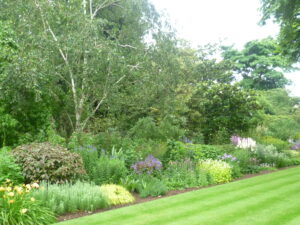
The Herbaceous Border, looking to the right
We headed straight for the 156 meter herbaceous border which rose in waves of flowers, one above the other, with the tall flowers, like the decorative thistles and the lofty acanthus at the back. There were bushes at mid-height, and tall trees at the very back. Whichever way I looked, the view of the herbaceous border reminded me of ocean rollers breaking on the shore.

A zoom in on the border
Each section was beautifully designed as you can see in the example above. I loved the variety of the shapes, the colours, the leaves etc. And the air was delicately scented. Every morning, the Queen gets a fresh posy picked from the herbaceous border. There must be hundreds of flowers to choose from – even in winter.
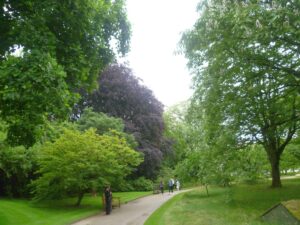
The trees are magnificent! I particularly like the copper beech on the left with people walking underneath it.
Then there are the trees! In the photo above, you can see one of the helpful attendants standing next to one of the many benches – the visitor meets an attendant about every 20 yards and he or she aims to know all about their section; the important plants, and, of course, the stories. And there are benches for visitors to sit on, too, as you can just make out in the photo above. The Palace garden has over 1000 trees, including the National Collection of mulberries, first planted by James I in 1608.
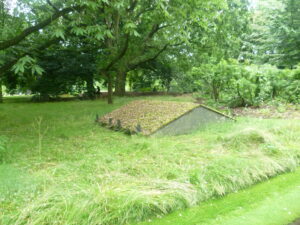
The cover for the sandpit
You can just see a corner of this in the previous picture. I wondered what it was – I thought that it might mark the graves of favourite dogs, perhaps – but no, it’s the cover for the sandpit dug for Prince Charles and Princess Anne back in the 1950s.
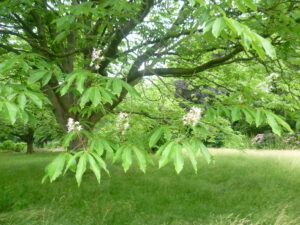
Indian chestnut blossom
Indian chestnuts are planted around the sand pit area – noted for the fact that their conkers are not prickly but much softer and, our friendly attendant told us, the royal corgis love playing with them!

The most magnificent tree of them all
The tree that struck me the most was the example above – and I’m not even sure what it is! What staggered me were the huge horizontal branches which came out almost at right angles and looked longer than the tree was high; you can judge its size by the couple sitting in the bench beneath it. It’s a Tolkien sort of tree, something you might expect to find in the Forest where Frodo meets Tom Bombadil. I found the way that the immensely long branches ended in what looked like huge claws definitely creepy. I wouldn’t care to be near it at night.

Lake with underwater spring?
And then we came upon the lake. It was not easily visible at first because of the lie of the land but, once we’d spotted it, we wandered down to take a look. There was a strange small whirlpool in the centre with bubbles – a hidden spring? And a couple of coot were swimming about. Sophie asked one of the attendants if there were herons – it looked a heron-y sort of place. The answer was no. There had been – until they ate up all the fish – whereupon, they vanished! The coot and the ducks are vegetarian – which I hadn’t realized – they eat pond weed which they dive down to the bottom of the lake to get at. I’d seen films of male water birds offering their prospective mates a beakful of strands of pondweed, but I’d assumed that it was for show, only. Now I know that it was much more of a romantic gesture – the equivalent of chocolate truffles, perhaps.

A coot on its nest underneath a weeping willow
The coot is famous for its untidy nest – see above.
At this point we felt in need of a cup of tea – and perhaps a scone with cream and strawberry jam. There was a tea and coffee stall – plus cakes – with benches nearby – perfect.

Buckingham Palace Victoria & Albert plane trees by John Campbell
Royal Collection Trust / © Her Majesty Queen Elizabeth II 2020
The last trees we wanted to see were the Victoria and Albert plane trees, planted by Queen Victoria and Prince Albert next to each other over 150 years ago. As they grew, they began, touchingly, to intertwine. We weren’t sure which tree was which, but we decided that the larger tree was probably Albert’s – but Victoria’s tree was not to be despised. She might have been a small woman but she was no pushover.
All photos by Elizabeth Hawksley, apart from the John Campbell photo above.
My guest, Sophie Weston’s take on the visit to Buckingham Palace Gardens is https://libertabooks.com/history/buckingham-palace-garden/
Elizabeth Hawksley
I am delighted that Crossing the Tamar is now out in e-books
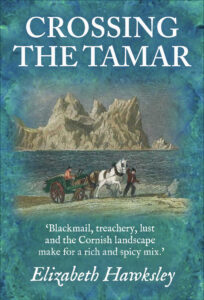
https://www.amazon.co.uk/dp/B096PKCFFD/
Please share this page...
What a marvelously well kept garden! I imagine there are all sort of interesting things hiding in that garden.
I think you are right, Huon. It certainly has a number of very rare and interesting trees; and the flower beds were meticulously kept. There was not a leaf out of place! And the lawn was pristine.